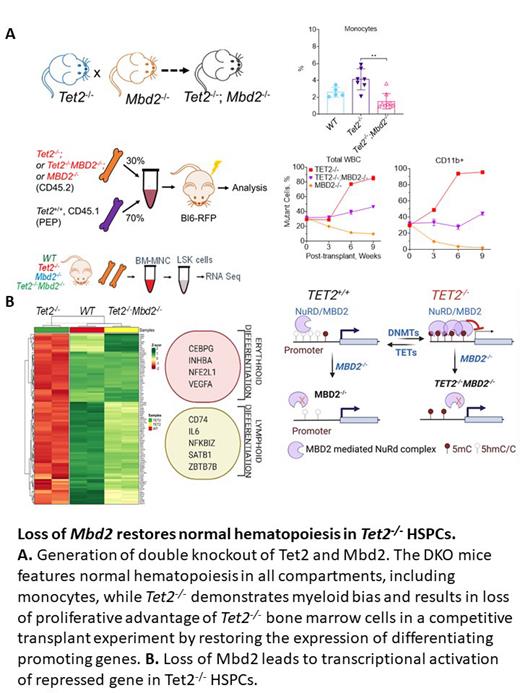Background & Significance.Epigenetic dysregulation leading to acquired disorganization of CpG methylation (mCpG) is a hallmark of cancer in general and myeloid neoplasia (MN) in particular. TET dioxygenases (TET1, TET2 and TET3) progressively oxidize 5-methyl cytosine (mC) to facilitate CpG demethylation, a process critical to efficient transcription, lineage differentiation, and proliferation. Loss of function TET2 mutation ( TET2 MT), the predominant TET in HSPCs, isone of the most common genetic lesions in MN and often occurs early in MDS/AML as a founder lesion. It is frequently observed in clonal hematopoiesis of indeterminate potential (CHIP) 1,2, a prodromal condition linked with increased risk of MN, coronary heart disease 3, and pulmonary arterial hypertension 4. TET2 MT results in abnormal accumulation of mC in the genome resulting in loss of lineage plasticity due to transcriptional repression of differentiation-promoting genes and tumor suppressor genes (TSGs), contributing to a volatile pre-neoplastic state. Indeed, the accumulation of mC at otherwise unmethylated promoter- and enhancer-associated CpGs is a hallmark cancer 2,5. The epigenetic reader mCpG binding domain protein 2 (MBD2) specifically recognizes mCpG, thereby modulating regional gene transcription 6. This modulation occurs through the recruitment of co-repressor complexes which deliver enzymatic machinery to reorganize chromatin into compact, inaccessible, and stably silenced regions. This tightly regulated process, required for normal development and cell lineage differentiation, is hijacked by malignant cells to maintain a pro-oncogenic transcriptional program. Therefore, MBD2 inhibition may restore the normal hematopoiesis in TET2 MT HSPCs and may represent a selective therapeutic target.
Methods.Genetic and epigenetic in vitro and in vivo model systems of clonal evolution including competitive repopulation assays and CRISPR-engineered cells coupled with NGS and biochemical analysis were used to establish the functional relevance of MBD2 in the clonal evolution of TET2 MT HSPCs. In addition, gene knockout or knockdown (ko/kd) were used to establish MBD2 as a novel therapeutic vulnerability in TET2 MT MN.
Results.Here we report that loss of TET activity, either by TET2 MT or by neomorphic IDH1/2 MT, selectively enriches promoter/enhancer mCpG contributing to malignant evolution of TET2 MT HSPCs that creates sensitivity to MBD2 inhibition. TET2 MT creates regional accumulation of mC that recruits the MBD2-NuRd complex, resulting in silencing of TSGs as demonstrated via MBD2 chromatin immunoprecipitation assay. MBD2 ko/kd in TET2 MT cells (SIG-M5, OCIAML-5) or isogenic CRISPR-engineered leukemic cells (THP1, K562) resulted in the termination of the malignant program as reflected in a complete loss of colony forming ability in vitro. Orthotropic transplant of SIG-M5 cells (10 5 cells/mice) created leukemia in SGM3-NSGS mice with a maximum survival of 45 days, however, MBD2 ko in transplanted cells resulted in 100% disease-free survival of these mice. To further test if Mbd2 loss is sufficient to restore normal hematopoiesis and if it can abrogate the proliferative advantage of Tet2 -/- HSPCs, we developed a Tet2 -/-;Mbd2 -/- double ko (DKO) murine model by crossing Tet2 -/-with Mbd2 -/- mice. The DKO mice developed normally with restored hematopoiesis within the myeloid lineage compared to Tet2 -/-. Most importantly, the proliferative advantage of Tet2 -/-HSPCs was ablated, as reflected in the mutant fraction of total WBC and the restoration of CD11b + myeloid cells following Mbd2 loss in competitive bone marrow repopulation assays ( Fig. A).This restoration was mainly driven by the transcriptional rescue of differentiation-promoting genes which were silenced by promoter methylation in Tet2 -/- HSPCs ( Fig. B).
Discussion & Conclusion.Here, for the first time, we demonstrate that MBD2 is required for maintaining the undifferentiated state of TET2 MT HSPCs with myeloid skewing. We provide several lines of evidence in human cells as well as in murine models that MBD2 is a targetable vulnerability in TET2 MT-associated leukemia. Our current findings provide a rationale for development of novel and potent non-cytotoxic therapeutic agents targeting MBD2 and their application in a biomarker-driven fashion for a large proportion of leukemias.
Disclosures
Maciejewski:Novartis: Honoraria, Speakers Bureau; Regeneron: Consultancy, Honoraria; Omeros: Consultancy; Alexion: Membership on an entity's Board of Directors or advisory committees.


This feature is available to Subscribers Only
Sign In or Create an Account Close Modal